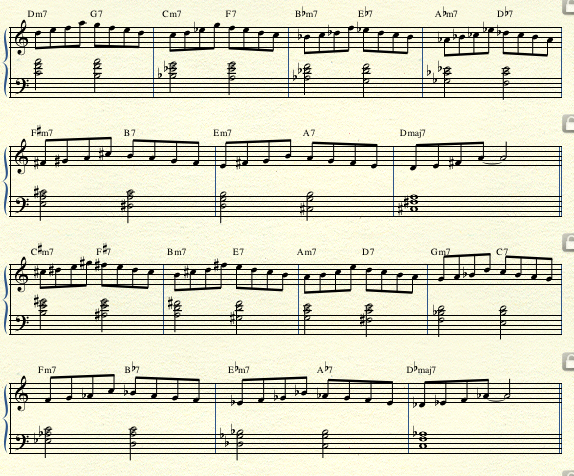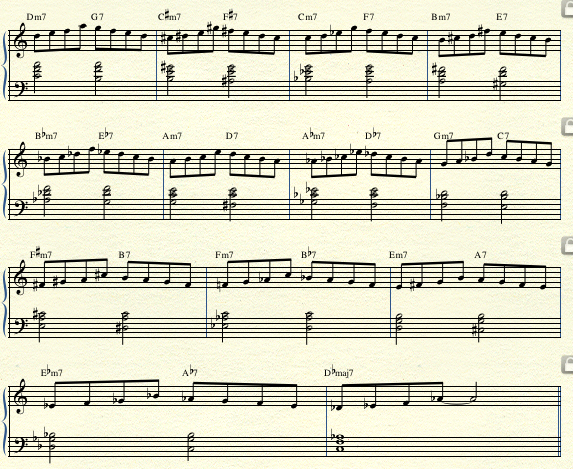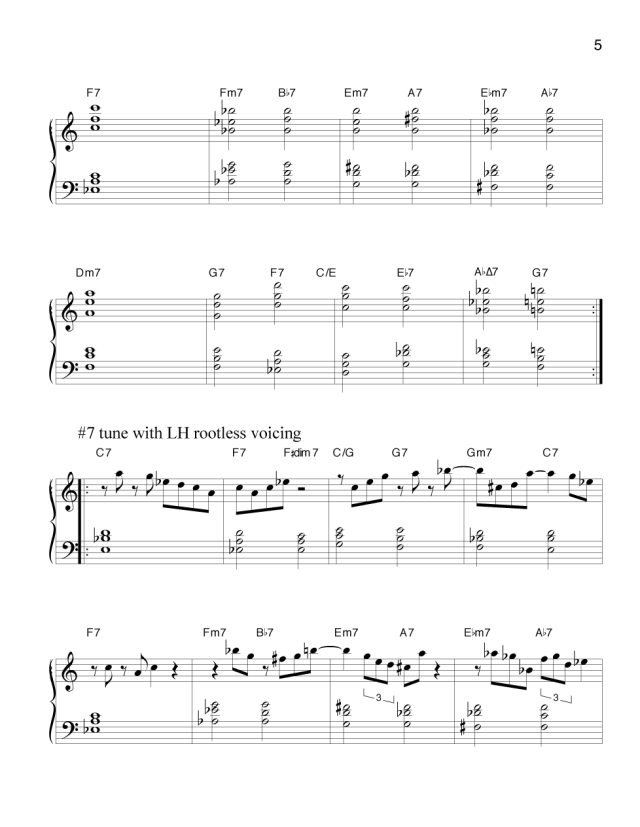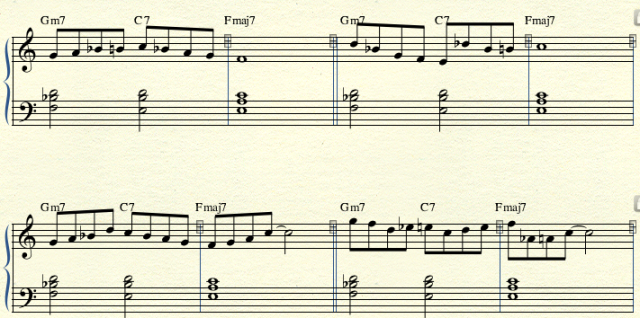Description to follow
Basics of Accompanying Singers
Description to follow
Jazz Harmony for Piano
Description to follow
Melodic Concepts for Jazz Piano: Volume 1
First of all, play through the tune using standard (spelled from bottom up) 3-7-9 and 7-3-5 voicings, and playing the root in the right hand. Do this in as many keys as possible, hopefully all 12!



There’s no shortcut for having some melodic “vocabulary” that you can run through all keys. Here are a couple of very easy patterns that might be helpful. If you’ve worked through the exercises already, the first should be very familiar. Although it’s built on the two-bar minor ii, dominant V/ major I progression, it works just fine on dominant V/major I, and, for that matter, on two bars of V, or two bars of I. You just need this stuff to help you connect your more melodic ideas. You can practice these either with or without the left hand at a slow tempo at first, then speed it up.

I like to practice these making up lines in the second bar of each lick, so we have a steady stream of eighth notes to work with. At least you have that capability, and part of your improvisational process is deciding not to play things you already know how to do. That is taking control of the music, which is what you want.
Melodic Concepts for Jazz Piano: Volume 2
The ability to come up with a steady stream of eighth notes on demand is essential in order to play bebop. Here I’ve taken an extremely simple 2-5-1 lick and run it through all keys, descending in whole steps.
Ex. 1

Here it is, descending in half steps.
Ex.2

Next, I take it, and using only the 2-5 part, play it descending in whole steps.
Ex.3

Here it is descending in half steps, common in tunes like Thelonious Monk’s Ask Me Now.
Ex.4

Here it is in ascending half steps, like John Coltrane uses in “Moments Notice.”
Ex. 5

This lick (and most any that outlines the changes well) can be played up a third, and up a fifth, diatonically, meaning, using the sharps and flats of the tonic key we’re in. (Cm7-F7-Bbmaj7 with two flats, F#m7-B7-Emaj7 with four sharps, etc)
Ex.6.

By having these patterns available at a rapid tempo, this allows the student time to think when moving from one idea to another. You don’t HAVE to play them. You should have them, in order to make a decision WHETHER to play them. I always encourage students NOT to play everything they hear. The great players always edit, as do the great composers.
There’s no shortcut for having some melodic “vocabulary” that you can run through all keys. Here are a couple of other patterns that might be helpful… you can practice them the same way you practiced the stuff above. Although these are built on the two-bar minor ii, dominant V/ major I progression, they work just fine on one bar dominant V/one bar major I, and, for that matter, on two bars of V, or two bars of I. You just need this stuff to help you connect your more melodic ideas. You can practice these either with or without the left hand at a slow tempo at first, then speed it up.
Melodic Concepts for Jazz Piano: Volume 3
We always ask students to learn their scales, and this is, of course, indispensable for developing as a jazz improviser. To really know a scale, and use it in a musical way, it’s really useful, and potentially fun, to learn them with commonly employed intervals before we try to insert them into tunes that we are playing.
So let’s take the most often used modes, and learn them not just linearly, but intervallically, using thirds, fourths, and triads.
For major, I’d learn Ionian (standard major) and Lydian (major with raised 4th). For minor, I’d practice dorian (natural minor with raised 6th) and melodic minor ascending (natural minor with raised 6th and 7th). And for dominant, I’d learn mixolydian (major with lowered 7th), Lydian/mixolydian (major with raised 4th and lowered 7th) and the “altered” scale (melodic minor ascending scale starting on the second degree). For extra credit, practice the half/whole scale (a symmetric scale alternating half and whole steps). You only need to practice this one in three keys, and it sounds great on the dominant chord! I also enjoy the locrian #2 scale (natural minor with a lowered 5th) used on the minor 7 b5 chord.
So here are the patterns on the Cmaj chord that we can practice, for now, using the Ionian mode. Of course, you should practice these in all keys, and in at least one of the major, minor, and dominant mode groups. We’ll start with learning them in thirds
Get the metronome on a slow tempo, and put it on beats 2 and 4.
Ex.1, 1a


Now do the same things with 4ths.
Ex.2, 2a


Practice with relatively even eighth notes, but accent the “and” of each beat. When playing examples 2 and 4, further accenting the “and” of 2 and “and” of 4 can improve the jazz feel somewhat.
Ex. 3

Practicing triads in this way is very useful. The cool thing that can happen here is the intersection of the “and” accents with the 3-eighth-note cross rhythm that naturally happens.
Ex.4

You could, of course, accent the top of each triad, rather than the bottom when you ascend, and accent the bottom of each triad when you descend. Or just play them accenting the “ands” of each beat.
You’ll find, after a while, these accents will start to come in and out in an individual way. Trust me. No one plays this stuff quite like anyone else. Everyone has a great eighth-note line inside them!
Ex.4a

You can probably come up with your own variations, which is a great thing. One I use sometimes, is a step followed by a third.
Ex. 5

Or, a step followed by a triad. Again, use your imagination!
Basics of Accompanying Singers: Volume 1
When playing behind a singer, you are one instrument, you and she. (I’m using feminine pronouns here for simplicity.) So try to imagine that her voice is a third hand to the right of your right hand. Always, always listen. Listen to the singer more than you listen to yourself. You will always sound good then, provided you know the music.
That’s first: Know the music. In jazz, this is problematic, as there are Richard Rodgers changes for “Blue Moon,” rock changes and jazz changes, all different. Knowing what works for the singer is pretty important. Changes are a subject for a whole ’nother column, so let’s assume here that you have worked out some changes for a jazz tune, like this one.

When working with a singer, you MUST know the melody; it’s not enough just to bang out the changes. For example, if you turn the Cmaj7 into a Cmaj9 (which is fine, normally), and you put the ninth in the top, it’s going to clash with the singer’s note and throw her off. As a general rule, make sure that the top note in your voicing has no clashing potential with the note that the singer is holding. Similarly, if the tune has upper extensions of the chord, this might not be notated in the voicing, so you have to know what they are anyway, to avoid putting in additions that clash with those extensions.
Notice that in the 10th bar, the notes F, G, Ab, Bb are consonant with a G7 b9 #9 chord. So if you play a G9 with a natural nine, even if the nine is buried in the chord, it’s going to sound wrong. So beware of lead sheets. Make sure that you as a pianist are not clashing with any chromatic note in the melody, unless it’s extremely brief, like a passing eighth note.
Another important thing to remember is NEVER OVERPLAY. Do not treat this as a piano gig with a singer accompanist. Her part is the melody and has to come first. Anything you do melodically and rhythmically to distract from that is not cool, unless the music specifically asks for that.
Try to find the minimal amount of notes that will work for the situation. Check with the singer to see what she thinks. Even singers who are not trained in music often have excellent rhythmic senses and know exactly what they need behind them. Let them count off their own tunes. If they are not comfortable doing that, let them snap their fingers, or whatever, and get the tempo from that. Look at everyone in the band and give a firm, loud count-off.
When you do “fills,” know the melody enough that you can play them in the rests of the melody, and sometimes over held long notes of a tune. Notice that in bar 8 the fill gives the singer the lead-in for the next part of the melody. This is good, considerate accompanying.
When doing “rubato” or “colla voce,” meaning out-of-tempo stuff, keep the tempo moving in the long notes of the voice so that the singer doesn’t run out of air. Also remember that “rubato” doesn’t actually mean out of tempo; it means MOVING tempo. So always give a pulse of some kind to the music even if it’s “out of tempo.”
The question always comes, especially when you are working in a duo with a singer: Do you lead her or does she lead you? This is something that always has to be discussed, unless the singer is unusually comfortable with a really open jazz setting. In general, the singer leads, but she might want you to lead at times. In that case, she has to tell you. So have an open, non-defensive dialogue about this. When a singer makes a comment about my playing, I sometimes feel as if I’m being criticized, but she is just telling me what she needs to sound at her best. It is your job to give the singer what she needs, because when you do, you sound at YOUR best.
– From an article originally published in Gig Magazine
Tune Learning
I find that many of my students learn a tune, and a year later, it’s forgotten. I think learning a tune is both an aural and an analytical process. In addition to listening to different recorded versions of a tune, (until you can sing the melody, and learn the lyrics if there are any) it’s really necessary to isolate the melody and harmony (both the chords and bass line) and master those. I’ve figured out a good step-by-step process to doing this. First practice the melody slowly, with a metronome, until it’s secure, then go on to the following steps.






Practicing: Part 1 – Warming up
I’m a big fan of a 15-to-20-minute warm-up. It relaxes me, focuses my attention on the tasks ahead and loosens up my fingers, hands and arms. I don’t focus on the individual fingers too much; rather, I like to make sure my arm rotation is happening … from left (as I play the thumb on my right hand) to right (as I play the fifth finger), and vice versa on the left hand. Allow the hand and arm to play the notes, unless the tempo is REALLY fast. Then engage the fingers, but don’t play too loud. Use full arm and shoulder weight for really loud passages.
More on this later. Today we’ll give you a great warm-up routine.
I got this from my teacher at Duke, the late Loren Withers, who was a student of Ernest Hutcheson, a former president of the Juilliard School. First, acquire, if you don’t have it already, the classic Hanon studies book (Schirmer, Vol. 925). On pages 50 through 64, he has very good fingerings for the 12 major and minor scales. Incidentally, his alternative fingering for the chromatic scale, on the bottom of page 64, I like very much.
Pick a metronome marking of, perhaps, quarter note = 60. Then practice your scales the following way:
Play scales in quarter note = 60, one octave. Start mp, get gradually louder, don’t stop on top, just get there, maybe at a forte dynamic, and come back, getting softer to the original mp.
Think about sound … make each note RIGHT with the metronome. No bumps in the sound; make the crescendo and diminuendo even and musical.
Now play in eighth notes, two octaves. Same approach.
Then, triplet eighths, three octaves.
Then I do my chromatic scale, starting on C. If I’m feeling good, I might omit the quarter notes here and go right to the eighth notes. Same approach.
Next, I would tackle dominant seventh chords (Hanon, pp. 70-71).
Quarter notes one octave, eighth notes two octaves, triplet eighths three octaves, 16th notes four octaves. Don’t skip any steps. Think rhythmically, and think about great tone. That’s what I love about the piano; even if you’re a beginner, you can get a great sound right away.
Next, use the same approach for major and minor triads. (Hanon pp. 65-68).
I’m not a huge fan of pounding through the Hanon uncritically, but there are some exercises in it that are of value:
On a particular day, I might pick one from pp. 22-43 and run it through a mode I’m trying to learn — in all keys, of course. I also think the trill exercise on pp. 76-77 is worthwhile. Keep the hand relaxed, and let the arm rotation help you execute the trill. Don’t do it with just the fingers.
Many of the Hanon exercises concern themselves with technical problems in mid-19th-century piano music and are not as useful to the modern jazz player. I’d rather a student practice Bach two-part inventions, easier Mozart and Beethoven, and Chopin preludes and etudes. I think you can get technically all you need to be a fine jazz pianist from these composers, throwing in a little Debussy and Ravel for tone color and balance.
Jazz Harmony for Piano: Volume 1
I constantly get questions about how to develop good jazz piano voicings. I’m currently writing a book about this very topic. Here are a few examples from it, and how to practice them.
1. There are two basic versions of every voicing: one with the 3rd (above the bass) on the bottom (the A version) and one with the 7th (above the bass) on the bottom (the B version). Good voice leading switches the two, so that the 3rd in the m7 chord resolves to the 7th in the next chord, and the 7th to the 3rd. Simply play this progression, and keep going with the pattern established; Am7 D7 Gmaj7, Gm7 C7 Fmaj7, Fm7 Bb7 Ebmaj7, Ebm7 Ab7 Dbmaj7, C#m7 F#7 Bmaj7, Bm7 E7 Amaj7. Notice each series of three chords progresses downward in whole steps.
2. In this example, the same progression is played, but now in descending half steps.
3. This is the same as #1, but with the 3rd and 7th reversed.
4. This is the same as #2, but with the 3rd and 7th reversed.
5. This is the same as #1, but with an added note, either the 9th or the 6th. The right hand is actually a great left hand voicing, too. So practice this with the hands reversed. Same with #6.
6. Same as #2 with the added note.
7. Now, we’ve added a 3rd or 7th to the left hand. This is called a “shell” voicing, and often serves in bebop piano as a minimal accompaniment to a linear right hand when there’s no bass player. We’ve changed the right hand so there’s no 3rd or 7th. Notice that there’s NO duplication of notes. This makes the voicing more sophisticated and contemporary sounding.
8. Same concept as #7 with the harmonic progression of #2. I’ve transposed the voicings so they sound good even when they get lower. In general, avoid the 3rd sounding below the C below middle C.
– Bill Cunliffe








